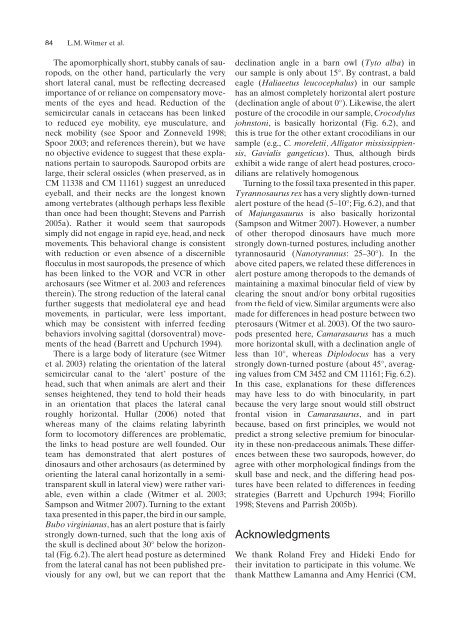Witmer, L. M., R. C. Ridgely, D. L. Dufeau, and M. C.
Witmer, L. M., R. C. Ridgely, D. L. Dufeau, and M. C.
Witmer, L. M., R. C. Ridgely, D. L. Dufeau, and M. C.
You also want an ePaper? Increase the reach of your titles
YUMPU automatically turns print PDFs into web optimized ePapers that Google loves.
84 L.M. <strong>Witmer</strong> et al.<br />
The apomorphically short, stubby canals of sauropods,<br />
on the other h<strong>and</strong>, particularly the very<br />
short lateral canal, must be refl flecting<br />
decreased<br />
importance of or reliance on compensatory movements<br />
of the eyes <strong>and</strong> head. Reduction of the<br />
semicircular canals in cetaceans has been linked<br />
to reduced eye mobility, eye musculature, <strong>and</strong><br />
neck mobility (see Spoor <strong>and</strong> Zonneveld 1998;<br />
Spoor 2003; <strong>and</strong> references therein), but we have<br />
no objective evidence to suggest that these explanations<br />
pertain to sauropods. Sauropod orbits are<br />
large, their scleral ossicles (when preserved, as in<br />
CM 11338 <strong>and</strong> CM 11161) suggest an unreduced<br />
eyeball, <strong>and</strong> their necks are the longest known<br />
among vertebrates (although perhaps less flexible fl<br />
than once had been thought; Stevens <strong>and</strong> Parrish<br />
2005a). Rather it would seem that sauropods<br />
simply did not engage in rapid eye, head, <strong>and</strong> neck<br />
movements. This behavioral change is consistent<br />
with reduction or even absence of a discernible<br />
flocculus fl in most sauropods, the presence of which<br />
has been linked to the VOR <strong>and</strong> VCR in other<br />
archosaurs (see <strong>Witmer</strong> et al. 2003 <strong>and</strong> references<br />
therein). The strong reduction of the lateral canal<br />
further suggests that mediolateral eye <strong>and</strong> head<br />
movements, in particular, were less important,<br />
which may be consistent with inferred feeding<br />
behaviors involving sagittal (dorsoventral) movements<br />
of the head (Barrett <strong>and</strong> Upchurch 1994).<br />
There is a large body of literature (see <strong>Witmer</strong><br />
et al. 2003) relating the orientation of the lateral<br />
semicircular canal to the ‘alert’ posture of the<br />
head, such that when animals are alert <strong>and</strong> their<br />
senses heightened, they tend to hold their heads<br />
in an orientation that places the lateral canal<br />
roughly horizontal. Hullar (2006) noted that<br />
whereas many of the claims relating labyrinth<br />
form to locomotory differences are problematic,<br />
the links to head posture are well founded. Our<br />
team has demonstrated that alert postures of<br />
dinosaurs <strong>and</strong> other archosaurs (as determined by<br />
orienting the lateral canal horizontally in a semitransparent<br />
skull in lateral view) were rather variable,<br />
even within a clade (<strong>Witmer</strong> et al. 2003;<br />
Sampson <strong>and</strong> <strong>Witmer</strong> 2007). Turning to the extant<br />
taxa presented in this paper, the bird in our sample,<br />
Bubo virginianus, has an alert posture that is fairly<br />
strongly down-turned, such that the long axis of<br />
the skull is declined about 30° below the horizontal<br />
(Fig. 6.2). The alert head posture as determined<br />
from the lateral canal has not been published previously<br />
for any owl, but we can report that the<br />
declination angle in a barn owl (Tyto alba) in<br />
our sample is only about 15°. By contrast, a bald<br />
eagle (Haliaeetus leucocephalus) in our sample<br />
has an almost completely horizontal alert posture<br />
(declination angle of about 0°). Likewise, the alert<br />
posture of the crocodile in our sample, Crocodylus<br />
johnstoni, is basically horizontal (Fig. 6.2), <strong>and</strong><br />
this is true for the other extant crocodilians in our<br />
sample (e.g., C. moreletii, Alligator mississippiensis,<br />
Gavialis gangeticus). Thus, although birds<br />
exhibit a wide range of alert head postures, crocodilians<br />
are relatively homogenous.<br />
Turning to the fossil taxa presented in this paper,<br />
Tyrannosaurus rex has a very slightly down-turned<br />
alert posture of the head (5–10°; Fig. 6.2), <strong>and</strong> that<br />
of Majungasaurus is also basically horizontal<br />
(Sampson <strong>and</strong> <strong>Witmer</strong> 2007). However, a number<br />
of other theropod dinosaurs have much more<br />
strongly down-turned postures, including another<br />
tyrannosaurid (Nanotyrannus: 25–30°). In the<br />
above cited papers, we related these differences in<br />
alert posture among theropods to the dem<strong>and</strong>s of<br />
maintaining a maximal binocular fi field<br />
of view by<br />
clearing the snout <strong>and</strong>/or bony orbital rugosities<br />
from the fi<br />
eld of view. Similar arguments were also<br />
made for differences in head posture between two<br />
pterosaurs (<strong>Witmer</strong> et al. 2003). Of the two sauropods<br />
presented here, Camarasaurus has a much<br />
more horizontal skull, with a declination angle of<br />
less than 10°, whereas Diplodocus has a very<br />
strongly down-turned posture (about 45°, averaging<br />
values from CM 3452 <strong>and</strong> CM 11161; Fig. 6.2).<br />
In this case, explanations for these differences<br />
may have less to do with binocularity, in part<br />
because the very large snout would still obstruct<br />
frontal vision in Camarasaurus, <strong>and</strong> in part<br />
because, based on fi first<br />
principles, we would not<br />
predict a strong selective premium for binocularity<br />
in these non-predaceous animals. These differences<br />
between these two sauropods, however, do<br />
agree with other morphological findings fi from the<br />
skull base <strong>and</strong> neck, <strong>and</strong> the differing head postures<br />
have been related to differences in feeding<br />
strategies (Barrett <strong>and</strong> Upchurch 1994; Fiorillo<br />
1998; Stevens <strong>and</strong> Parrish 2005b).<br />
Acknowledgments<br />
We thank Rol<strong>and</strong> Frey <strong>and</strong> Hideki Endo for<br />
their invitation to participate in this volume. We<br />
thank Matthew Lamanna <strong>and</strong> Amy Henrici (CM,

















